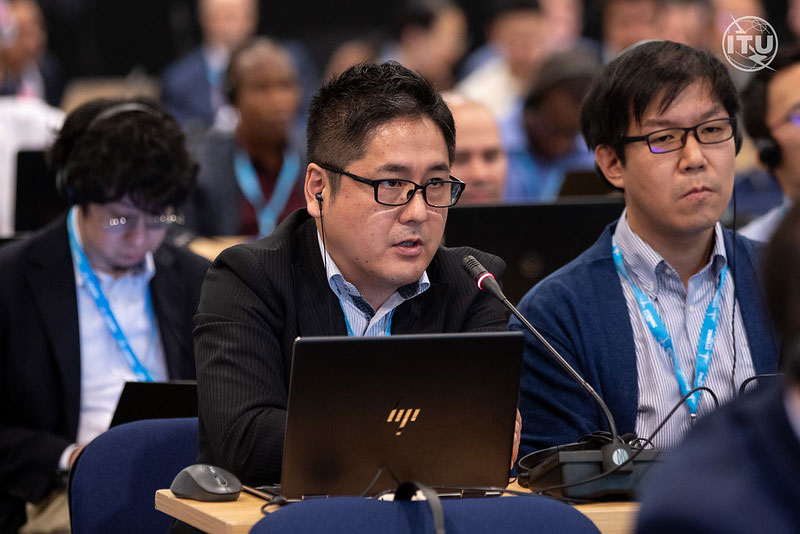
From November to December 2023, the International Telecommunication Union (ITU)’s World Radiocommunication Conference 2023 (WRC-23) was held in Dubai, United Arab Emirates. SoftBank Corp. (TOKYO: 9434) was there representing Japan, along with the country’s Ministry of Internal Affairs and Communications. At the conference, an official decision was reached to add spectrum which could be used for High Altitude Platform Station (HAPS) base stations in stratospheric-based wireless communication systems. The positive result comes after SoftBank led various initiatives at the ITU and in the Asia-Pacific region.
About the World Radiocommunication Conference (WRC)
Held every three to four years by the International Telecommunication Union (ITU), a United Nations agency for information and communication technologies, the WRC makes decisions on the use of radio spectrum on a global level. The WRC is attended by members from regulatory authorities in various countries, regional groups that represent six geographical regions and private sector companies, including telecommunication operators.

Photo provided by ITU
Enabling the implementation of HAPS services around the world
SoftBank is actively working toward the commercialization of HAPS-based communication services. As part of these efforts, SoftBank has been engaged in international standardization activities through the International Telecommunication Union's Radiocommunication Sector (ITU-R) and the Asia-Pacific Telecommunity (APT) to expand spectrum bands available for HAPS mobile base stations. The World Radiocommunication Conference (WRC) is an important conference that decides on international spectrum management and allocation, and its decisions serve as the basis for determining spectrum allocations at the national level.
To achieve direct-to-device communications between HAPS mobile base stations flying in the stratosphere and commonly used smartphones on the ground, smartphone-compatible spectrum bands need to be used. Previously, only the 2GHz band was available for use by HAPS mobile base stations, but it is only a small part of the spectrum used for mobile phone communication worldwide. To realize the commercialization and adoption of HAPS, which is expected to help bridge the digital divide, expanding spectrum allocation for HAPS is a prerequisite.
Accordingly, SoftBank has been working actively since 2018 to add the 700-900MHz band, the 1.7GHz band, and the 2.5GHz band, which are frequencies used globally for mobile phones, at WRC-23. SoftBank has also been actively engaged in technical studies at specific ITU-R meetings, and in coordinating a regional proposal in APT with the goal of revising ITU Radio Regulations, and leading related regulatory discussions in both.
The spectrum bands approved at WRC-23 are already being used for terrestrial (ground-based) services in many countries around the world and can be used with existing smartphones. By making it possible for operators and governments to select spectrum bands with flexibility, it is expected that the introduction and development of HAPS-based mobile broadband communications will spread across various countries and regions around the world.

For 6 years, SoftBank team coordinated efforts to expand HAPS spectrum
Shiro Fukumoto and Kentaro Sakata from the Spectrum Policy Management Office in SoftBank’s Regulatory Division reflected on their time spent at WRC-23, which lasted for approximately one month, and their preparations.
Sakata “The agenda items for WRC-23 were adopted at WRC-19, which was held in 2019. So the whole process, including preparation, took about six years. First, we spent about two years getting the items on the agenda for WRC-23 at WRC-19, and then spent about four years conducting various activities, such as performing technical studies at the ITU-R and consolidating views of various countries within APT. In the year leading up to WRC-23, we traveled to various countries around the world almost every month to obtain support from other countries and regions on our views so that other regions’ common proposals to WRC-23 would also be supportive of the expansion of HAPS spectrum.


“Decisions at WRC are consensus-based and we had prepared well for this, however we still struggled to reach an agreement at WRC-23. When the decision to add the spectrum bands was finally approved in the final week, there was a great sense of accomplishment given the approximately six-year timespan of our efforts. We believe that by leading discussions at ITU-R meetings, including WRC-23, and by participating in regional preparatory meetings, we were able to establish Japan’s presence in the HAPS industry. We were also able to lobby governments around the world about the need for HAPS, including those in countries that could see potential future deployments.”
Fukumoto “I think the series of efforts we made leading up to and at the WRC to add spectrum bands was a first for SoftBank, and we’re very satisfied with the overall result. The spectrum bands added at WRC-23 are already being used by other systems on the same or adjacent bands in some countries and regions. So there were some differing opinions from other countries and regions about the use of these spectrum bands for HAPS and conditions were made to protect other systems when using them. Through our leadership in discussions as Japan and as a Japanese company, we were able to reach a compromise in the creation of international rules that considered HAPS usage in Japan and future overseas expansion without imposing excessive constraints on operations.

Photo provided by ITU

Photo provided by ITU
“In her closing remarks on the final day of WRC-23, the ITU Secretary-General mentioned HAPS as one of the game-changers in the future of connectivity, reaffirming its position as a highly anticipated solution worldwide. We expect that the decision reached at the WRC-23 will be appropriately reflected in the regulations of each country, and we plan to work with industry associations such as the HAPS Alliance to ensure this is implemented.”

Team members from SoftBank’s Regulatory Division at WRC-23
From left: Tomomi Nagatsu, Shiro Fukumoto, Kyohei Sakamoto, Kentaro Sakata, Noan Yoshida
For more information, see this press release.
HAPS: Stable communication for all people and things

Learn more about how SoftBank is working to establish new infrastructure to create a society where people and things are connected around the world.
(Posted on January 30, 2024)
by SoftBank News Editors


